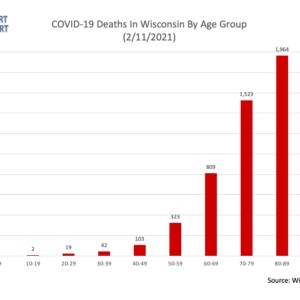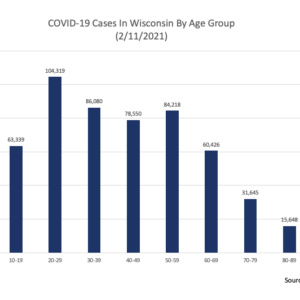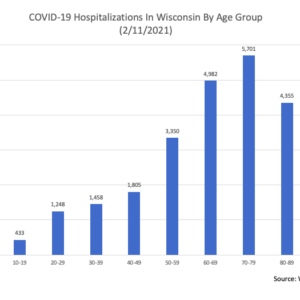
[bctt tweet=”A CDC study done in WI found only seven of 191 confirmed cases were linked back to in-school transmission, suggesting that schools might be able to safely open with appropriate mitigation efforts in place.” username=”MacIverWisc”]
What does the data and the science show about the safety of our children returning to the classroom and in-person instruction?
February 12, 2021
By Abbi Debelack
The data shows it is safe to return to in-person instruction.
Many studies have found transmission of the Coronavirus in schools to be amazingly low, given the close contact students and teachers have with one another. The Center for Disease Control (CDC) recently published new findings that support in-person instruction. They conducted a study among rural Wisconsin schools during the Fall 2020 semester. Within the schools, masking and social distancing were strictly enforced. The report concluded that “With masking requirements and student cohorting, transmission risk within schools appeared low, suggesting that schools might be able to safely open with appropriate mitigation efforts in place.” Of the 191 confirmed cases of students and staff, only seven, or 3.7%, were linked back to in-school transmission. This data collected within our own state shows that, by following CDC guidelines, it is possible to safely resume in-person instruction.
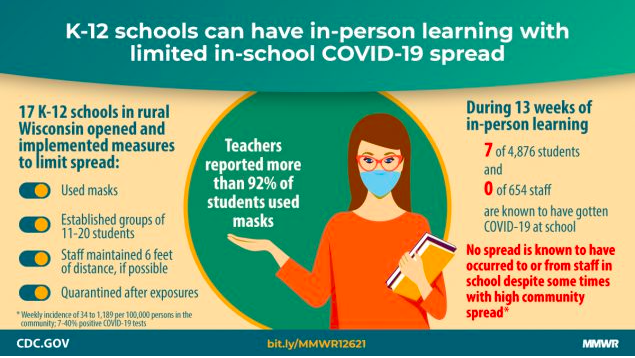
The CDC study is not the only study that shows schools should fully re-open. As The Heritage Foundation recently reported, “The largest study to be published on the issue so far, using data from the United Kingdom, finds no increase in severe coronavirus-related outcomes for adults living with children who go to school. It demonstrated a small increase in infections, which didn’t result in any noticeable bad outcomes.”
Many scientists have admitted that students are more likely to pick up the virus at home rather than at school. Dane County health officials conceded this in their Emergency Order #9, saying in the order itself, “A recent analysis also showed a higher proportion of adults with COVID in Dane County had symptoms compared to school-aged children and that the most common risk factor among school-aged children was household contact with a confirmed case.” In their Emergency Order closing down schools, Dane County admits children are more likely to contract the virus at home and, yet, many schools in Dane County and across the state are still shut down.
“The most common risk factor among school-aged children was household contact with a confirmed case”
A study done by the American Academy of Pediatrics found in select North Carolina schools, “Over 9 weeks, 11 participating school districts had more than 90,000 students and staff attend school in-person; of these, there were 773 community-acquired SARS-CoV-2 infections documented by molecular testing. Through contact tracing, NC health department staff determined an additional 32 infections were acquired within schools. No instances of child-to adult transmission of SARS-CoV-2 were reported within schools.” We are being told constantly by the mainstream media and teachers’ unions that schools are deadly hotspots of the virus. Yet, this peer-reviewed report conducted by 13 doctors found “extremely limited within school transmission,” and no confirmed instances of a student passing on the disease to their teacher.
Duke University studied 6,800 students and staff members in YMCA summer camps and found “Just 10 children and nine staff members with confirmed symptomatic cases of COVID-19 – and believe only two of the cases were contracted at the camps themselves.” In a setting where close contact between children and staff is nearly inevitable, this positivity rate of only 0.3% is truly eye-opening. This study helps make the case that schools — where much stricter social distancing techniques are in place — can safely be open to in-person instruction.
President Biden’s own CDC Director, Dr. Rochelle Walensky, recently admitted that schools can safely reopen with proper precautions in place.
Many teachers’ unions and school boards have been adamant that teachers cannot safely return to the classroom until staff can be fully vaccinated. However, the Director of President Biden’s CDC claims this is not the case. Dr. Walensky says, “There is increasing data to suggest that schools can safely reopen and that safe reopening does not suggest that teachers need to be vaccinated.”
The CDC also states, “The preponderance of available evidence from the fall school semester has been reassuring…There has been little evidence that schools have contributed meaningfully to increased community transmission.” Many schools have successfully mitigated the disease in their district by implementing social distancing and mask requirements to both students and teachers.
“The preponderance of available evidence from the fall school semester has been reassuring…There has been little evidence that schools have contributed meaningfully to increased community transmission.”
While many Wisconsin schools — including larger districts like Milwaukee Public Schools — remained closed to in-person learning throughout the fall semester and now into the spring, many districts successfully and creatively found ways to resume in-person instruction. Little Chute School District, near Appleton, has implemented an effective hybrid model for grades 7-12, with elementary students being in the classroom full-time. Through the first semester, “district contact tracers have only found evidence of in-school transmission in four of 108 confirmed cases among students and staff.” This tremendous success should be used as a model for other districts across the state.
The research is clear: it is safe to bring students and teachers back into the classroom for in-person instruction. Studies conducted across the state and country highlight the low-levels of transmission in schools that have already returned to face-to-face education following suggested safety guidelines, such as masks and social distancing.
Another Reason to Open Schools – Students Are Failing in the Virtual Education Model and Falling Behind
Study after study has found that virtual education does not compare to the instruction given in person. Rather than rely on a national study or generic findings, we can look to data from Wisconsin to answer the question of the effectiveness of virtual instruction. We can look to Waukesha schools, where 28% of students are failing at least one class, a 265% increase from prior years. This is an astonishing increase. The school board was recently presented with the data to suggest that 57% of these failures occurred in classes in a hybrid model.

The Post Crescent recently reported that one in four Appleton School District High School students failed a class last semester. Students with disabilities and English language learners are disproportionately represented in students failing a class. The district’s assistant superintendent of assessment, curriculum, and instruction, Steve Harrison, attributed the failure rate to “the extremely unprecedented year.”
Additionally, in a December School Board meeting at the Wausau School District, the board was presented with a student achievement update. Unsurprisingly, the data follow trends similar to other schools in the state. The Freshmen class has seen a 350% increase in failed classes from 2019-2020. Across grades 9-12, the average increase in F’s is around 208%.
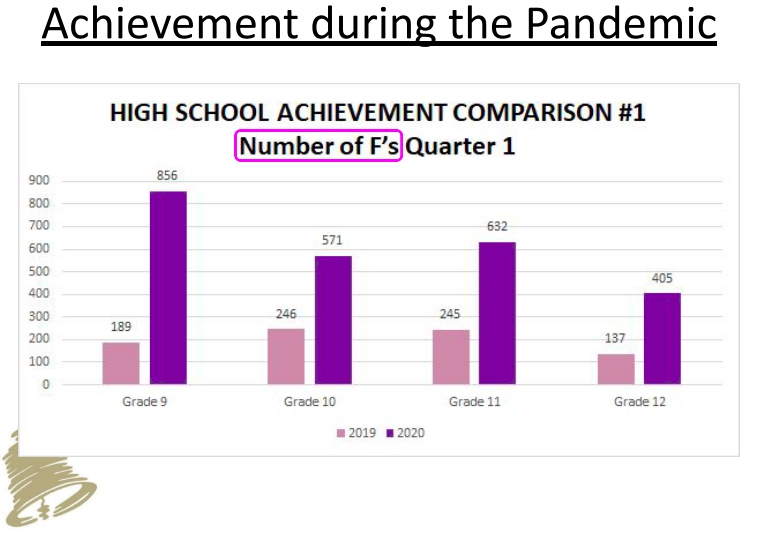
The MacIver Institute submitted an open-records request to the Wisconsin Department of Public Instruction to gather this data for districts across the state. The response from DPI stated “Wisconsin is a local-control state, meaning districts have different curriculum and grading systems in place. This specific grading information is not required to be reported to the DPI.” It seems hard to believe that DPI is making decisions for state-wide testing and instruction without answering questions as basic as how many students are failing one or more classes.
An additional consequence of the move to virtual instruction is the impact lockdowns have had on the mental well-being of students. Wisconsin Public Radio recently reported the impact that being away from fellow classmates and teachers is having on children. The report found “Emergency room visits, usually the first point of entry when children have a mental health crisis, have risen 24 percent for children ages 5 to 11, and 31 percent for ages 12 to 17, from April to October in 2020.” These visits account for only the reported cases of mental health crises throughout the early months of the pandemic. Without the ability to communicate face to face with teachers, school psychologists, and other classmates, students will continue to struggle with the forced isolation.
Despite data that encourages in-person learning, some teachers are being pressured to remain in-favor of virtual instruction. A survey of the Racine Educators Union (REU) recently obtained by WISN’s Dan O’Donnell reveals the pressure being placed on teachers by the unions which represent them. Questions such as “Are you prepared to do whatever it takes to maximize the preservation of life, health and safety of students, families and staff in our community?” and “Can we count on you to join fellow educators in a car caravan/funeral procession on Sat., Jan 23 in Racine to highlight returning teachers to the building is unsafe?” It is clear from the language of this survey, the teachers’ union has no intention of returning teachers back to the classroom anytime soon.
The data is clear. Schools are not COVID-19 hotspots, contrary to what we are constantly told by the mainstream media and teachers’ unions. In-school transmission is rare for both students and teachers. It is also clear that many students are struggling to adapt to virtual or hybrid models of instruction. Wisconsin must fully re-open our schools now, get back to in-person instruction and some sense of normalcy before our children fall further behind. We must act now.
